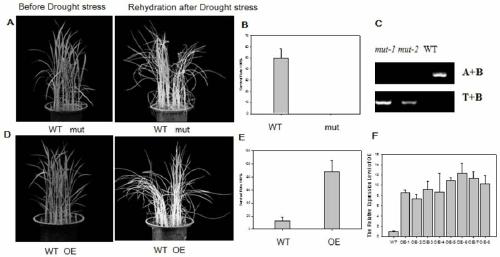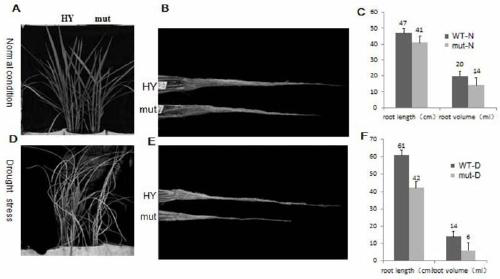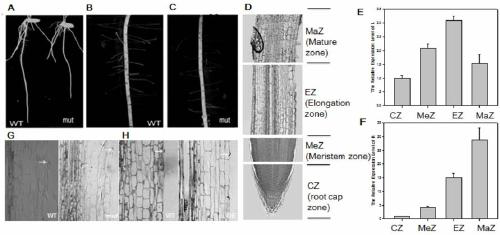Application of OsNMCP1 gene in controlling drought tolerance in rice
A rice and genetic technology, applied in the fields of application, genetic engineering, plant genetic improvement, etc., can solve the problems of affecting plant growth, restricting plant growth and development, increasing crop production and income, etc.
- Summary
- Abstract
- Description
- Claims
- Application Information
AI Technical Summary
Problems solved by technology
Method used
Image
Examples
Embodiment 1
[0026] Example 1: Isolation and cloning of the OsNMCP1 gene
[0027] The applicant used the TRIZOL reagent (purchased from Invitrogen Company) to extract total RNA from the leaves of the sequenced rice variety Nipponbare (the original material was from the Institute of Crop Science, Chinese Academy of Agricultural Sciences, which was a routine experimental material) (the extraction method was according to the above-mentioned TRIZOL reagent instruction manual), using Reverse transcriptase SSIII (purchased from Invitrogen) was used to synthesize cDNA by reverse transcription, and the reaction conditions were: 65° C. for 5 minutes, 42° C. for 120 minutes, and 70° C. for 10 minutes. Using this cDNA as a template, the full-length cDNA (2964bp, see the sequence table SEQ ID NO: 2). PCR reaction conditions: pre-denaturation at 95°C for 3min; 35 cycles of 94°C for 30sec, 60°C for 30sec, and 72°C for 3min; extension at 72°C for 10min. The PCR product obtained by amplification was con...
Embodiment 2
[0028] Example 2: Isolation and identification of osnmcp1 mutants
[0029] The T-DNA insertion mutant 1C-01360 (nm1, Hwayoung background) corresponding to the OsNMCP1 gene locus was picked from the Korea Postech Rice Mutant Library (http: / / www.postech.ac.kr). Among them, the flanking sequence of the nm1 mutant 1C-01360 registered in the mutant library of the above website (the sequence length is 1121bp), the sequence is as follows:
[0030] ATCAGCGTACGTGCTTTTGAGTTCAGGCGCACATCTTTATGTAAATAATTTGCATTAGGTCGCTCATCAATGTCATTCGTGCTAGTAGTATTTGTTTGAGTTTGACTAAACTTCAGGTTTTGTTTTAGACGCAGACGACCACTAATGATTTTCCGTCGTGGGGTGCACTAATAGAACGTCTGAACGTTTTCTGCGTGCTTAGACGAGTTCACATTGACCATCAATTTAGTACTAAAAAATTAGCAGAATATTTAGCAGGGTTTGTACTACTTAACTACTTATTGAAATAGAGTTTTATTTGCTATAAATCTTTCGTATTGATCTGTAAAGACAAAATAACATAGTTGTAACAGCGTCCTAATAAATACTTCCTAATCAATTTACCCAAAGTAGGTGGGAATGAAATGGGAAGCTTGGCAAAGGGTAATCAATTTCATGAACAATCATTTTCTGATATAATGAAACAGACATCCTCATTAATCTTCAGTTGAAACAGACATCCTGAAACATGGACCCGACACTGAGAAATTTGGCACGGCCTTACTTA...
Embodiment 3
[0035] Embodiment 3: Construction and transformation of OsNMCP1 gene overexpression vector
[0036] The method for constructing the overexpression vector is as follows: firstly, the positive clone p1301U-OsNMCP1 plasmid obtained in Example 1 was correctly sequenced and then used for transformation. That is, it was introduced into the rice variety ZH11 through the rice genetic transformation system mediated by Agrobacterium, and after pre-cultivation, infection, co-cultivation, screening of hygromycin-resistant calli, differentiation, rooting, seedling training, and transplanting , to obtain transgenic plants. The Agrobacterium-mediated genetic transformation system of rice (japonica subspecies) was reported by Hiei et al. (Hiei et al., Efficient transformation of rice, Oryza sativa L., mediated by Agrobacterium and sequence analysis of the boundaries of the T-DNA, Plant J, 6:271-282, 1994) was improved on the basis of. A total of 20 independent transgenic rice plants were ob...
PUM
 Login to View More
Login to View More Abstract
Description
Claims
Application Information
 Login to View More
Login to View More - R&D
- Intellectual Property
- Life Sciences
- Materials
- Tech Scout
- Unparalleled Data Quality
- Higher Quality Content
- 60% Fewer Hallucinations
Browse by: Latest US Patents, China's latest patents, Technical Efficacy Thesaurus, Application Domain, Technology Topic, Popular Technical Reports.
© 2025 PatSnap. All rights reserved.Legal|Privacy policy|Modern Slavery Act Transparency Statement|Sitemap|About US| Contact US: help@patsnap.com



